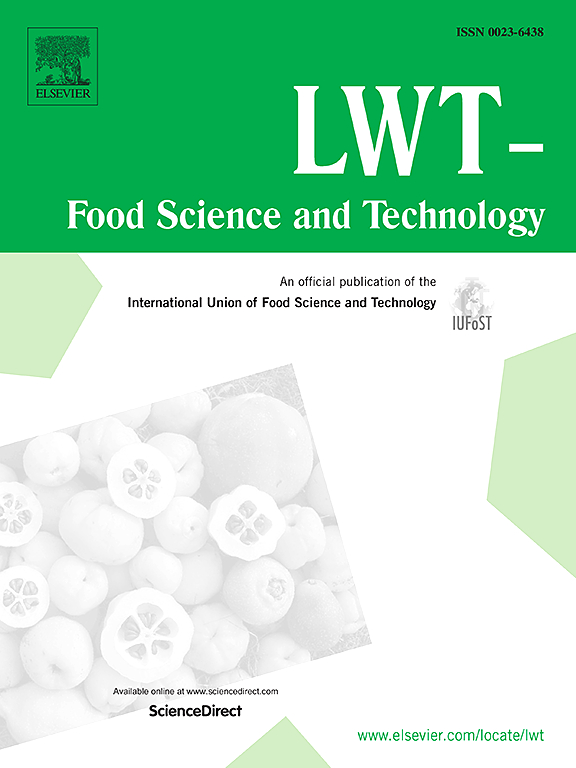冷藏凤尾蛤和波形巴菲蛤中气单胞菌的质量变化、多样性和毒力
IF 6
1区 农林科学
Q1 FOOD SCIENCE & TECHNOLOGY
引用次数: 0
摘要
气单胞菌是一种广泛存在的机会性细菌,被认为是新兴的人类病原体和水生食品中的腐败细菌。这些细菌通常存在于未煮熟的海鲜中,对消费者构成健康风险。本研究旨在评估气单胞菌在新鲜亚洲硬蛤(HC)和幼蛤(BC)及其冷藏(HC- r和BC- r)中的流行率和毒力。从添加氨苄西林的气单胞菌培养基中分离得到124株。通过API 20 NE试剂盒和MALDI-TOF/MS鉴定,102株(82%)属于气单胞菌属。MALDI-TOF/MS进一步鉴定这些分离株为A. hydrophila (35%), A. veronii(23%)和其他(42%)。冷藏蛤比新鲜蛤表现出更大的微生物多样性。随机选取34株菌株进行毒力分析。61.8%(21/34)的菌株有溶血作用,8.8%(3/34)的菌株有蛋白酶活性。16S rRNA测序显示,冷藏会改变微生物群落,增加与腐败相关的属,如弧菌、雪瓦氏菌、迷走球菌、乳球菌和气单胞菌。新鲜和冷藏的蛤蜊都含有致病性和与腐败有关的气单胞菌,这突出了严格的海产品加工、储存和处理措施的必要性。适当的烹饪和卫生习惯对于减轻受气单胞菌污染的蛤蜊的健康风险至关重要。本文章由计算机程序翻译,如有差异,请以英文原文为准。
Quality changes, diversity and virulence of Aeromonas spp. in the refrigerated Meretrix meretrix and Paphia undulata clams
Aeromonas spp. are opportunistic and widespread bacteria recognized as emerging human pathogens and spoilage bacteria in aquatic foods. These bacteria, often present in undercooked seafood, pose health risks to consumers. This study aimed to assess the prevalence and virulence of Aeromonas spp. in fresh Asian hard clam (HC) and baby clam (BC) along with their refrigerated (HC-R and BC-R) counterparts. A total of 124 isolates were obtained from Aeromonas medium base supplemented with ampicillin. Identification using the API 20 NE kit and MALDI-TOF/MS confirmed that 102 isolates (82 %) belonged to the Aeromonas genus. MALDI-TOF/MS further identified these isolates as A. hydrophila (35 %), A. veronii (23 %), and others (42 %). Refrigerated clams exhibited greater microbial diversity than fresh counterparts. Among them, 34 isolates were randomly selected and tested for virulence profiling. Hemolysis was observed by 61.8 % (21/34) of isolates, while 8.8 % (3/34) displayed protease activity. 16S rRNA sequencing revealed that refrigerated storage altered microbial communities by increasing spoilage-associated genera like Vibrio, Shewanella, Vagococcus, Lactococcus, and Aeromonas. Both fresh and refrigerated clams contained pathogenic and spoilage-associated Aeromonas spp., highlighting the need for stringent seafood processing, storage, and handling measures. Proper cooking and hygiene practices are essential to mitigate health risks from Aeromonas-contaminated clams.
求助全文
通过发布文献求助,成功后即可免费获取论文全文。
去求助
来源期刊

LWT - Food Science and Technology
工程技术-食品科技
CiteScore
11.80
自引率
6.70%
发文量
1724
审稿时长
65 days
期刊介绍:
LWT - Food Science and Technology is an international journal that publishes innovative papers in the fields of food chemistry, biochemistry, microbiology, technology and nutrition. The work described should be innovative either in the approach or in the methods used. The significance of the results either for the science community or for the food industry must also be specified. Contributions written in English are welcomed in the form of review articles, short reviews, research papers, and research notes. Papers featuring animal trials and cell cultures are outside the scope of the journal and will not be considered for publication.
 求助内容:
求助内容: 应助结果提醒方式:
应助结果提醒方式:


